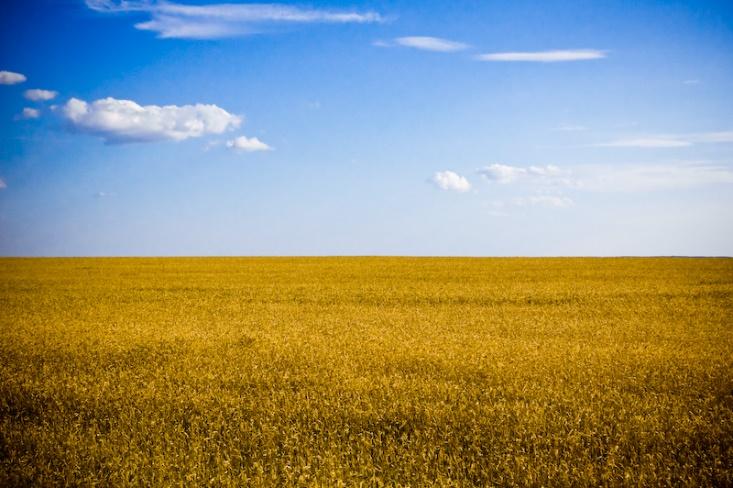In the global wheat trade, Ukraine looms large. Until it recently suspended wheat exports, it accounted for a majority of wheat imports in a number of countries in Africa and South Asia. Similarly, the World Food Programme has recently obtained a majority of its wheat from Russia and Ukraine. Russia has also been a top exporter of fertilizers, and the region is an important supplier of agricultural commodities more generally.
All of this is of course threatened by the current conflict, which in addition to creating a humanitarian and economic crisis may have large implications for global food security. Many conflicts, some of which have claimed far more lives than that in Ukraine has to date while receiving less Western media coverage, contribute to local and regional food insecurity, but in most cases their effects on global markets have been smaller. Conflict in Ukraine is having a large effect on global markets, with the price of benchmark SRW wheat for May delivery in Chicago rising as much as 70% from mid-February to last week. Prices have moderated a bit in recent days and those for 2024 delivery have remained basically stable. But in a larger context, these price increases occur on top of supply chain disruptions and a worsening food security situation before the crisis (see https://www.growfurther.org/grim-findings-show-food-insecurity-is-getting-worse/).
Egypt has been preparing
Frequently the world’s largest wheat importer, Egypt at one point was getting nearly 85% of its wheat from Ukraine and Russia. The Egyptian government subsidizes bread and vegetable oil for its population, for which Ukraine plays an even bigger role in the world market than for wheat, but has limited capacity to deal with major supply disruptions. As Middle East Institute analyst Michael Tanchum noted, “The fragile state of Egypt’s food security stems from the agricultural sector’s inability to produce enough cereal grains, especially wheat, and oilseeds to meet even half the country’s domestic demand.”
For Egypt’s government, this is not a threat to take lightly—sharp, sudden spikes in food prices have sparked street rioting and even toppled regimes there before. But the country has been working hard to ease its dependency on foreign wheat. Egypt’s farmers made great strides in boosting wheat supplies in the recent past thanks largely to agricultural innovation.
Last year, the United States Department of Agriculture highlighted Egypt\’s success in boosting wheat yields per hectare over six years. The increase in output achieved was thanks in part to expanded use of higher-yielding varieties and more strategically timed planting, according to a report by USDA’s Foreign Agricultural Service. Egypt also expanded its area of land under wheat cultivation through “laser leveling techniques,” “raised bed cultivation,” and other innovative land-use practices, the USDA report noted.
But Egypt is an arid country with only so much arable land. Climate change is threatening to make the country drier and less hospitable to agriculture. New research out of Australia may point to a way forward.
In a newly released article appearing in the journal Nature Climate Change, Australian researchers say they believe a combination of drought-resistant wheat varieties, early seasonal planting, and deeper sowing could boost wheat yields by up to 20% in some circumstances. The scientists argue that by planting wheat earlier and deeper, the seeds can take advantage of residual soil moisture remaining in the ground, even under drier conditions. If the seeds are of a more drought-resistant variety of wheat, then those plants stand a better chance of surviving prolonged dry spells after breaking the surface. The study relied on data from Australia, but the authors argue that their findings apply to similar agricultural climate zones throughout the world, including those in Egypt. “Most of the drylands under agriculture are used for cereal crops, with wheat being one of the most important crops,” they pointed out (https://www.nature.com/articles/s41558-022-01305-9).
Ethiopia hopes for a wheat revolution
Ethiopia, where smallholder farming dominates, is also increasingly vulnerable to conflict-related wheat shortages. Just a year ago, a research study published in the journal Agronomy for Sustainable Development warned that Ethiopia was growing dangerously dependent on imported wheat to feed its burgeoning population (https://doi.org/10.1007/s13593-020-00654-z). Researchers estimate that Ethiopian wheat is grown by some 4.2 million smallholder farmers, the vast majority of whom rely on the rains to irrigate their crops. Thus, Ethiopia will need climate-resilient wheat varieties and climate-smart farming practices moving forward, as well. To adapt, the government in Addis Ababa was gearing up to launch a major drive to boost wheat yields per hectare. Unfortunately, an outbreak of armed conflict in northern Ethiopia has largely derailed those plans. Agricultural innovation isn’t enough. Ethiopia also needs peace if it’s to secure enough wheat for its population.
Grow Further hopes for a peaceful solution to the conflict in Ukraine. In the meantime, we applaud the governments, researchers, and farmers who have been working to make wheat production resilient to this and other crises, and aim to support them and to inform the public on the importance of agricultural innovation. As Socrates noted almost 2500 years ago, “Nobody is qualified to become a statesman who is entirely ignorant of the problem of wheat.”
— Grow Further
If you would like to support immediate food relief needs for residents and refugees from Ukraine, the UN World Food Program, which takes donations via World Food Program USA, is among the organizations working on the ground.
Photo credit: Ukraine’s vast wheat fields serve as the inspiration for that nation’s flag. Ilya Dobrych, Creative Commons.




